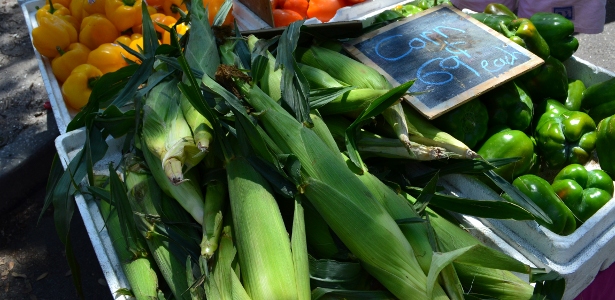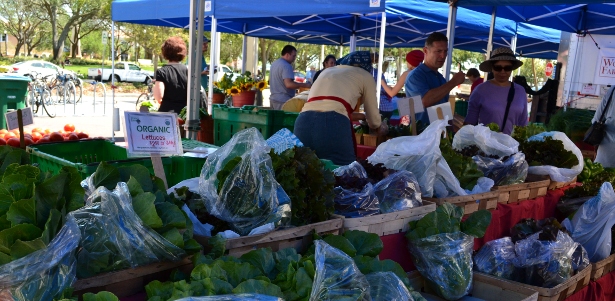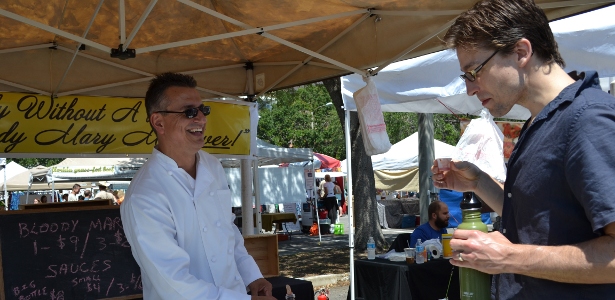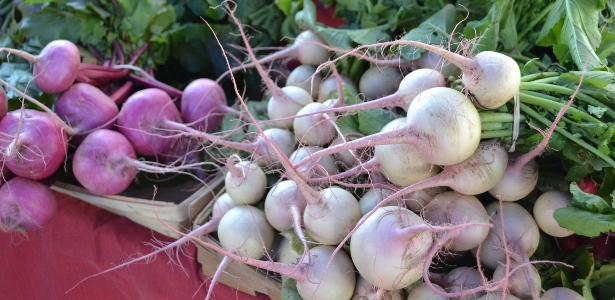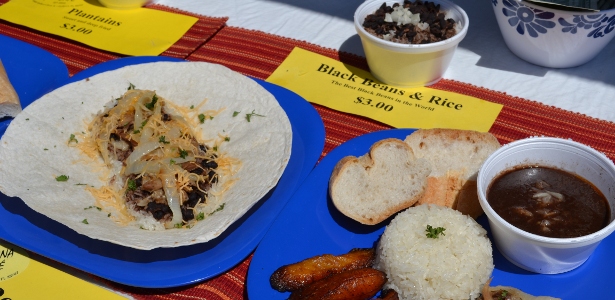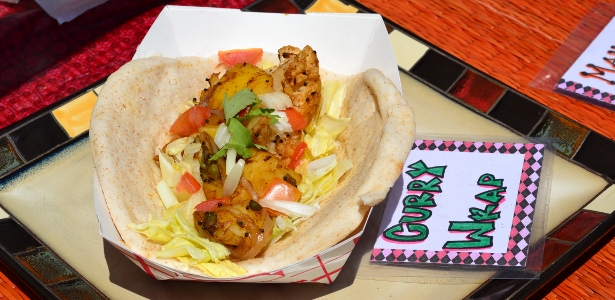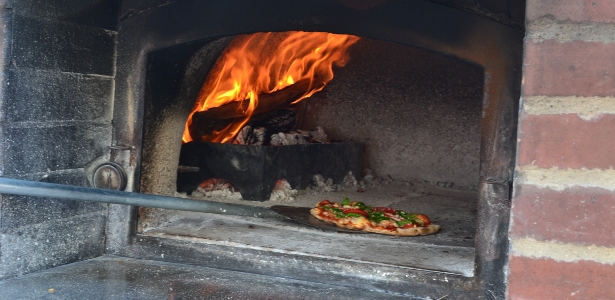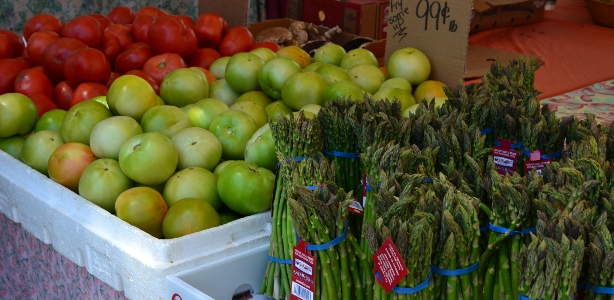10 Food Strategies for Plane Trips
We fly a lot – and we’ve learned that even in the chaos of last minute packing, it’s critical to take the time to prep a food carry on.
Of course, a few days before a flight, we always log on to the airline website to choose the best possible “Special Meal” option — assuming that a meal is being served it all. We also always consider it a bonus if we get something edible – and that is usually on international carriers like Emirates or China Air where plant-based dishes are part of the native cuisine. On domestic flights, food is usually a snack, there’s no way to request anything special and, surprisingly, it’s almost never plant-based – except for the occasional carrot and celery sticks with two cherry tomatoes and diary dip that you can buy.
So we’ve learned:
1. Keep a box of those little 1.5 oz size hummus containers from Costco in the fridge (a dozen to a box for a little more than what they sell one for with pretzel crisps at
airport kiosks). You can even buy a big bag of those great pretzel crisps and plastic bag them. I take enough for a round trip and store them in the mini-bar at the hotel.
2. Make big roll-up sandwiches spread with veggie dips and stuffed with other goodies that won’t spoil. (recipes to follow). Cut them in fourths on the diagonal and bag each quarter in a sandwich baggie.
3. Pack a quart size bag of celery sticks, broccoli florettes, cauliflower stems, jicama sticks, skinny asparagus, grape tomatoes, and raw (or par boiled) carrot sticks for dipping in the hummus or just munching.
4. Throw in fruit – apples, pears, grapes (especially grapes), bananas (be careful where you put them, they can really make a mess).
5. Nuts! I always have a bag of almonds in my purse. Also, keep a trail, granola or other snack mix on hand so it’s easy to bag a few handfuls. Also toss in a half dozen good granola bars.
6. Find a small insulated pack and keep it handy for loading up. We have a tall, flat bag with a velcro top that was a give-away at a convention. It takes up a lot less room – packed and empty – then the cube-shaped ones with handles. One of these makes it easier to manage the food in a cramped economy seat and keeps the food from oozing onto your books or Kindle.
7. Carry tea bags. I’ve been drinking green tea for way more than a decade so I got in the habit of always having some tea bags in my purse – since in the early days restaurants didn’t know what it was. A flight attendant will usually be happy to provide hot water – and airlines that serve tea as a standard alternative to coffee make it in advance with not such great quality black tea.
8. If you have access to an airport club, they are generally more in tune with their customers than the airline catering services. We have found the little hummus containers, small peanut butter cups, pitas, fresh fruit, fruit “cocktail,” quality snack mixes, pretzels – and they don’t seem to mind if you pocket a few items for the trip
9. Troll the food kiosks on the gate-side of security for unexpected finds – the offerings are getting better and better (that’s where we first discovered the hummus cups and pretzel crisps). But the prices are also getting higher and higher. So this is a good place for inspiration if not shopping.
10. Bring enough to share. If you are traveling with a friend or business colleague, be sure you have enough for both of you – an offer to share will almost always be gratefully accepted (even by meagens*).
*Our grown son, the only one of us not eating a plant-based diet, has dubbed himself – and others of his ilk – a “meagen.”
Suitcase Staples for Plant-Based Diets
To keep the hunger wolves from the door, whenever I travel, I always pack a few essentials – and always confirm that I will have a hot water (coffee) maker in my room and, ideally, a mini bar. You never know where your next plant-based meal is coming from – and if you are working, there isn’t a lot of time to forage (more on that later).
1. Green Tea – After a long day, a cup of green tea, preferably freshly brewed loose, is the best. But a good quality bag tea does just fine in a pinch. And sometimes, that’s the only viable option.
- Bag tea – my favorite is Kirkland (yes, we’re Costco fans…) about $12 for 100
- Loose tea – One of my top go-to resources is adagio.com. They sell a huge variety of loose teas and sample packs – little tin boxes that are perfect for travel. And they also offer a very clever one-cup tea infuser – IngenuTea – that travels well. Fill it with loose tea and hot water, let steep and then put it on top of your cup. A pressure valve releases the steeped tea into your cup. Infuser with 4 samples $19 (great holiday gift, too.) http://www.adagio.com/gifts/holiday_ingenuiTEA.html
2. Miso Soup Packs – Kikkoman makes two that I like – Shiro Miso and Tofu Miso. Just add hot water. They are available in a many supermarkets,, Asian stores, health food stores or by the box 12 for $30 (Costco.com again)
3. Noodle Bowls – if you have room in your luggage, these are easy last minute meals or snacks, but read the labels carefully. they are not all vegan.
- Nong Shim’s Bowl Noodle Soup with Kimchi flavor is good (about $1.50) and
- Thai Kitchen makes some bowls ($2+) and bigger “carts” that are more readily available in supermarkets. The noodle bowls that are vegan are: Roasted Garlic, Mushroom, Spring Onion and Hot & sour. All the noodle carts are vegan: Pad Thai, That Peanut, Roasted Garlic, Thai Sesame
4. Nuts – baggies of almonds, cashews, pecans and walnuts (yes, they’re high in fat and calories – but it’s good fat with lots of minerals)
5. Instant Oatmeal – a couple packets
6. Dried fruit – including dried cranberries, blueberries, mangoes, unsulphured apricots,, etc.
7. Sesame Seaweed Rice Balls & Seedy Nutty Wafers (Trader Joe’s)
8. Pretzels – crisps and pumpernickel
Cow’s Milk given to infants may create Type 1 Diabetes
Ten statistically significant studies demonstrate a noteworthy increase in Juvenile Onset (Type 1) Diabetes in children who were not breast fed and, instead, were given cows’ milk during the first two years of life.
According to T. Colin Campbell, Ph.D. “A very specific sequence of 17 amino acids found in cows’ milk generated production of a specific antibody and that antibody … discovered exactly the same 17 amino acid sequence on the cells of the pancreas that was producing the insulin.” Once it attacked those cells, that child’s pancreas could no longer produce insulin – ever.
It is also now known, for example, that certain children have a much greater genetic susceptibility to the cow’s milk amino acid sequence with the additional presumption that, perhaps, these children were also exposed to a particular kind of virus as well. So, according to Dr. Campbell, Type 1 Diabetes could result from an unhappy combination of genetically susceptible children being exposed to cows’ milk and perhaps also to a certain kind of virus.”
Remarkably, the association between Type 1 Diabetes and cows’ milk coupled with high-risk genes, is even greater than the relationship between smoking and lung cancer. A 12-country study demonstrated that the higher the consumption of cows milk, the higher the incidence of type 1 Diabetes. Since 1992, The Academy of Pediatrics has warned against giving cows’ milk to children younger than one for a variety of reasons so one must wonder why this information is not more widely publicized.
According to Sayer Ji, on WakeUp-World.com, “in genetically susceptible individuals the consumption of cow’s milk may trigger an autoimmune destruction of the beta cells in the pancreas which produce insulin. A new study published in the journal Archives of Pediatric and Adolescent Medicine, has shed light on a possible new mechanism behind this connection.
“Finnish researchers looked at 1113 infants with a genetic susceptibility to type 1 diabetes and who were randomly assigned to receive one of three infant formulas during the first 6 months of life whenever breast milk was not available:
- Cow’s milk formula (CMF)
- Whey-based hydrolyzed formula (WHF)
- Whey-based formula free of bovine insulin (insulin-free CMF)
“Beta cell autoimmunity was monitored at ages 3,6, and 12 months and then annually until 3 years of age. The results were reported as follows: Since 1992, The Academy of Pediatrics has warned against giving cows’ milk to children younger than one for a variety of reasons so one must wonder why this information is not more widely publicized.
“In comparison with ordinary CMF, weaning to an insulin-free CMF reduced the cumulative incidence of autoantibodies by age 3 years in children at genetic risk of type 1 diabetes mellitus. The likelihood of finding autoantibodies associated with beta cell autoimmunity was 25% lower in the whey-based hydrolyzed formula group, and 61% lower in the insulin-free whey-based formula when compared with the cow’s milk formula group”.
REFERENCES:
“Insulin-free whey-based cow’s milk formula is associated with lower incidence of beta cell autoimmunity in infants and young children.” Arch Pediatr Adolesc Med. 2012 Mar 5. Epub 2012 Mar 5. PMID: 22393174
Committee on Nutrition. “The Use of Whole Cow’s Milk in Infancy” Pediatrics Vol. 89 No. 6 June 1, 1992; pp. 1105 -1109
Hammond-McKibben D, and Dosch H-M. “Cow’s milk, bovine serum albumin, and IDDM: can we settle the controversies?” Diabetes Care 20 (1997): 897-901
Karjalainen J, Martin JM, Knip M, et al. “A bovine albumin peptide as a possible trigger of insulin-dependent Diabetes Mellitus.” New Engl. Journ. Med 327 (1992): 302-307
.
“Insulin-free whey-based cow’s milk formula is associated with lower incidence of beta cell autoimmunity in infants and young children.” Arch Pediatr Adolesc Med. 2012 Mar 5. Epub 2012 Mar 5. PMID: 22393174
Committee on Nutrition. “The Use of Whole Cow’s Milk in Infancy” Pediatrics Vol. 89 No. 6 June 1, 1992; pp. 1105 -1109
Hammond-McKibben D, and Dosch H-M. “Cow’s milk, bovine serum albumin, and IDDM: can we settle the controversies?” Diabetes Care 20 (1997): 897-901
Karjalainen J, Martin JM, Knip M, et al. “A bovine albumin peptide as a possible trigger of insulin-dependent Diabetes Mellitus.” New Engl. Journ. Med 327 (1992): 302-307
.
Hotel Tips for Plant-Eaters
A lot of my travel finds me in hotel rooms with limited room service menus and even more limited restaurants. I usually have a list of possibilities from HappyCow.com but very often, it’s late and traipsing around unfamiliar territory looking for an obscure address (or a casual dining restaurant that can at least rustle up a baked potato and broccoli) gets very old very fast.
So I always try to travel with some quick fixes that I can eat in the room. We keep a basket on the kitchen desk to toss in “finds” to pack for the next trip.
The things I am always looking for are easy, lightweight snacks that I can prepare in a hotel room with hot water from the coffee maker (be sure that you swing out the basket other the water will take like coffee – the oils cling to everything). It has to come with its own bowl or work in a hotel cup.
An all-time favorite is Instant Miso Soup – Kikkoman makes several variations that are readily available – usually three to a package. And they also make a good Wakame Soup as well.
Another good bet are the vegan quick fixes form Thai Kitchen – two with their own bowls are
Kitchen’s Instant Rice Noodle Soup: Garlic & vegetable and Spring Onion
Rice Noodle Soup Bowls: Roasted Garlic, Mushroom, Spring Onion, Hot & Sour
Instant oatmeal, is a great standby – but not so necessary any more as most hotel dining rooms will provide real oatmeal. But it’s quick and easy and works in a mug
If the travel distance isn’t too great, I throw in a few extra small container of Hummus – see the earlier post on “Hummus is a Gel” which is a reminder that only small packets will work.
Nuts – almonds, walnuts, pecans, cashews – in small packages
Beware: Hummus is a Gel
The only way to insure that we all have enough to eat on planes, is to carry it on. Not starving is a function of how creatively you can run the security gauntlet with your food intact.
We discovered that security (at least the one in Mobile, AL) sees hummus (and baba ganouj) as potentially dangerous gels – even in the sealed 4 ounce size. On the way to Mobile, Delta served ham and cheese on thickly buttered bread – so we were determined not to starve on the way home.
Spotting a health food store on the way to the airport, we stopped for a late lunch and loaded up for the trip home. It had taken two days to get there (“weather” delays) and we feared the worst on the trip north. We can fly to Beijing, Cairo or Dubai with no delays but we can’t get to a wedding in Alabama without serious problems on both legs. So it was with more than some dismay that we saw our unopened containers of hummus, baba ganouj and guac perched forlornly on the top of the X-ray machine. (And we did end up delayed in Atlanta on the way home – with nary a plant-based snack in sight.)
Solution: Spread the spreads on wraps and roll ’em up – or stuff pita pockets. Security doesn’t seem to confiscate sandwiches. And tuck some prepared veggies in your carry on – security doesn’t bother with those either.
Roll-Ups To Go – Plant-based traveling food
Whether it’s a car, plane, boat or train trip, we always pack roll-ups to go. They stay fresher longer than bread sandwiches and they look more festive. For variety, I stock a few different kinds of “bases” — whole wheat flour tortillas, chapatis, and, my favorite, Toufayan’s big sheets of multi-grain lavash flat bread. Lavash doesn’t get soggy until past edible for other reasons – and it’s only 110 calories each.
The Spreads: Hummus, sweet potato, curried carrot dip, mustard, tahini, or vegan dijonaise or horseradish mayo (Mix Spectrum’s low-fat canola mayo with Dijon mustard or with bottled horseradish).
The Fillings: Choose a variety of textures and colors: crunchy, creamy, crisp and soft. Left over roasted root vegetables, julienned carrot sticks, daikon radish, jicama, fennel, celery, broccoli stems or kohlrabi , cucumber spears (seeds removed, salted & drained), dill pickle sticks, baked tofu rectangles, sauteed tempeh strips, “bacon-like” analog, romaine lettuce (stem removed or chiffonaded), large leaves of Boston or butter lettuce, par-boiled collard leaves (or raw, finely sliced and massaged with oil and lemon). Instead of tomatoes, that can escalate the sogginess process, try stirps or whole roasted red peppers (either fresh or jarred – Trader Joe’s sells several varieties that are well-priced.)
The Wrap: Thinly cover all but the outer edge of the wrap with one of the spreads, next layer the romaine, lettuce or collard leaves, then along an outer third of the wrap stack the fillings so that each one runs the width of the wrap – mix a variety of crunch and soft – sticks, strips, chiffonaded greens, etc. Then season with one of the salt-substitutes and lots of freshly ground pepper and perhaps a little freshly ground sea salt. Moisten the filling with a drizzle of the same spread or a different one. Start rolling the wrap at the filling end. (If the wrap will “sit” for a long time, consider layering the greens first and then adding the spread.)
Cut the smaller roll-ups in half on a diagonal and the larger ones in fourths; bag each piece separately in a sandwich baggie (or plastic wrap) and roll up the baggie tightly around the wrap. Bag all in a larger freezer bag with a couple napkins inside to absorb the moisture.
“Special Meals” – Really?
When we order an airline’s “Special Meal,” we always hold our breath as we peel back the foil cover- you just never know what’ll be underneath. We’ve tried Special Meals on many, many carriers and the results are invariably surprising – good and bad. When we fly an airline that caters to a variety of cultural and religious dietary requirements, we each order different “plant-based” meal categories just to see what we’ll get. But on most airlines, you’re lucky if you find vegetarian – and if vegan is listed, it often becomes all too clear that someone in the food chain doesn’t know what that means.
On Delta, we were served cold assorted steamed vegetables for a salad and the same steamed vegetables hot for our main course – with canned fruit for dessert. On one of Olympic Airs’ last flights, we were served lovely grilled vegetables flanking three breaded rectangular logs. We poked and prodded – tempeh? seitan? We finally tasted it – chicken! I assumed that China Air would be easy (and I didn’t pack the usual carry on) but my meal turned out to be the local JFK caterer’s take on plant-based – not Chinese. My tray didn’t look like anyone else’s – and the identical food was served for every meal. Edible but disappointing. After 18 hours, I really wished I had packed more than granola bars.
Emirates, one of our favorite airlines, delivers delicious ethnic plant-based meals – along with a really fabulous entertainment system. Air Mexico is hit or miss – they do vegetarian fine, but cheese and other dairy seems to sneak into everything. Shorter domestic flights rarely have a veg option – take the meat and cheese off the well-buttered roll and that’s dinner.
We will start logging our meals more carefully – and taking pictures. If we all do that, then we might effect a difference. In the meantime, the more food we can carry-on the better. Coming up- “Strategies for Plane Trips.”
Dr. John McDougall Challenges Paula Dean
Whole-food, plant-based Diet Guru John McDougall has challenged cook book author and TV personality Paula Dean to a bet. He has invited Ms. Dean, who recently admitted that she has Type 2 Diabetes, to spend ten days at his center learning how to eat healthfully.
Dr. McDougall’s bet: “Would we love a trim-looking Paula Deen on a cooking show? How would we react if she lost weight and cured her diabetes right in front of our eyes? I am willing to make a giant effort to help Paula help herself and America become trimmer and healthier. I am publically inviting her to my 10-day, live-in clinic in Santa Rosa, CA. As an added incentive, I am offering her a Mitt Romney size bet* that my Program will change her personal health and her style of cooking on her future TV shows. Furthermore, if she attends my program and does not make the significant positive changes that I predict, then I will be a guest on her cooking show and eat sliced beef wrapped in bacon strips and fried in chicken fat. Otherwise, if the McDougall Program does, as I confidently predict, cause her to lose weight, lower her blood sugar, and get her off her diabetic drugs, then she will agree to be a speaker at my next Advanced Study Weekend, September 7-9, 2012, and prepare a five-course, low-fat vegan meal with a starch centerpiece, ending with a healthy dessert.”
http://www.drmcdougall.com/misc/2012nl/jan/deen.htm
Sadly, it appears that she is using this platform to promote the diabetes drug, Victoza.
Paula Dean Admits to the Country’s #1 Life-Style Disease – Type 2 Diabetes
Paula Dean, Food Network’s queen of artery-clogging cuisine, has just acknowledged that she has Type Two diabetes. When every recipe starts with “take two sticks of butter” and finishes with “sprinkle the top with two cups of grated cheese,” this should not come as a huge surprise. Type 2 diabetes has long been recognized in prominent scientific circles as the poster child of life-style diseases. Hopefully Ms. Dean will take this opportunity to read the literature, treat her disease with a whole-food, plant-based diet rather than drugs, change what she sells on her show, and make a real difference across the US.
Read the full story on the Huffington Post. http://www.huffingtonpost.com/kristin-wartman/paula-deen-diabetes_b_1220459.html
Studies have demonstrated that a whole-foods plant-based diet can reverse Type 2 diabetes in many people, and can dramatically reduce the need for drugs in others.
Plant-Based Days-After-Thanksgiving Meals
We are visiting family for the Thanksgiving week-end. The main dinner is “covered” but there are two more days of meals to consider. My sister and mother are fabulous cooks but the pantry will likely have few of our standard vegan items on the shelves.
So here’s what we’re planning to truck with us (in addition to what we’re planning for dinner – see previous post):
Soy milk – aseptic- packaged
Lentils & Kombu for lentil soup
Broccoli and potatoes for Cream of Broccoli soup
Extra-Firm and Silken Tofu – aseptic-packaged – for dips and dressings
Vegan Dijonaise (Spectrum Low-fat Canola Mayo plus Dijon mustard) – for sandwiches
Baked Tofu – for sandwiches
Tubes of concentrated Vegetable broth (Trader Joe’s)
Prepared White Bean Dip (Costco)
Spiced Carrot Spread
Hummus
